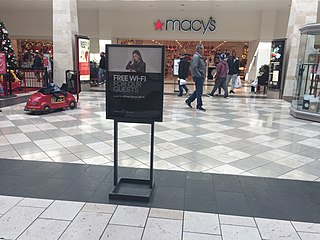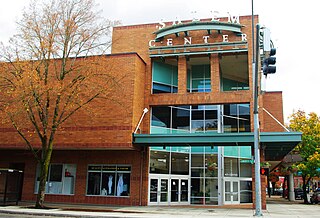
Nordstrom, Inc. is an American luxury department store chain. Founded in 1901 by John W. Nordstrom and Carl F. Wallin, it originated as a shoe store and evolved into a full-line retailer with departments for clothing, footwear, handbags, jewelry, accessories, cosmetics, and fragrances. Some stores feature home furnishings and wedding departments, and several have in-house cafes, restaurants, and espresso bars.

Parisian Inc. was an American chain of department stores founded and headquartered in Birmingham, Alabama. Competing mainly in the established Southeastern US market through the 1980s against Nordstrom, Neiman Marcus and Gus Mayer, Parisian underwent a series of restructurings and mergers during its 130-year history, and was taken over by Proffit's, Inc. in 1996. In September 2006, Belk purchased the Parisian department store properties from Saks for $285 million, although that sale did not include the Parisian nameplate. Five Parisian store locations in Michigan, Indiana and Ohio were instead sold to Bon-Ton, and closed nine additional stores nationwide. The remaining twenty-four locations were rebranded as Belk in September 2007, except for the three Michigan stores, which continued to operate as Parisian until rebranding as Carson's in 2013, later to close in 2018.

Del Amo Fashion Center is a three-level regional shopping mall in Torrance, California, United States. It is currently managed and co-owned by Simon Property Group.
L. S. Ayres and Company was an Indianapolis, Indiana, department store founded in 1872 by Lyman S. Ayres. Over the years its Indianapolis flagship store, which opened in 1905 and was later enlarged, became known for its women's fashions, the Tea Room, holiday events and displays, and the basement budget store. As urban populations shifted to the suburbs, Ayres established branch stores in new shopping centers in several Indiana cities. Ayres also acquired retail subsidiaries in Springfield, Illinois; Fort Wayne, Indiana; and Louisville, Kentucky. Ayr-Way, the Ayres discount store subsidiary, became the first discount store launched by a full-line department store. By the end of the 1960s Ayres had become a diversified merchandising business with retail department stores, a chain of discount stores, specialty clothing stores, a home furnishings showroom, and a real estate holding company. A long-time Ayres slogan, "That Ayres Look", promoted the company as a fashion leader, and by 1972 it had become the oldest continuous retail slogan in the United States.

Lloyd Center is a shopping mall in the Lloyd District of Portland, Oregon, United States, just northeast of downtown. It is owned by Arrow Retail of Dallas and anchored by Macy's. The mall features three floors of shopping with the third level serving mostly as professional office spaces, a food court, and U.S. Education Corporation's Carrington College.

Chinook Centre is the largest shopping mall in Calgary, Alberta, Canada. It is located near the geographic centre of the city on Macleod Trail, north of Glenmore Trail about 5 km (3.1 mi) south of downtown, and three blocks west of the Chinook C-Train station. The mall is operated by Cadillac Fairview.

Boise Towne Square is a mall in the western United States, located in Boise, Idaho. The largest retail complex in the state, it opened in 1988 after more than 20 years of planning, and features 150 stores, with Macy's, JCPenney, Kohl's and Dillard's as anchor stores. The mall also includes the first Apple Store in Idaho. Boise Towne Square is owned by the Chicago-based Brookfield Properties Retail Group and is located near the junction of Interstate 84 and Interstate 184.
Lafayette Square Mall is a super-regional shopping mall in Indianapolis, Indiana, United States. Developed in 1968 by Edward J. DeBartolo Sr., the mall is managed by Jones Lang LaSalle and owned by Ashkenazy Acquisition Corp. Its current anchor consists of Shoppers World.
The William H. Block Company was a department store chain in Indianapolis and other cities in Indiana. It was founded in 1874 by Herman Wilhelm Bloch, an immigrant from Austria-Hungary who had Americanized his name to William H. Block. The main store was located at 9 East Washington Street in Indianapolis in 1896. The company also identified itself as The Wm. H. Block Co., and Block's.

Castleton Square is an enclosed shopping mall in the Castleton neighborhood on the northeastern side of Indianapolis, Indiana, United States. Built by Edward J. DeBartolo Corporation and Homart Development Company in 1972, it is owned and managed by Simon Property Group. It is the largest mall in the state of Indiana, and has remained so since its construction. The center's original anchor stores were J. C. Penney, Sears, Lazarus, and Woolworth. Expansions in 1990 and 1998 added to the total number of anchor and inline stores, while also adding a food court. The mall's anchor stores are AMC Castleton Square 14, J. C. Penney, Dick's Sporting Goods, Macy's, and Von Maur, with one vacant anchor last occupied by Sears. Overall, Castleton Square consists of over 130 inline stores, including H&M and Forever 21.

Stratford Square Mall is a shopping mall that opened on March 9, 1981, in Bloomingdale, Illinois, a northwestern suburb of Chicago, Illinois, United States. The 1,300,000-square-foot (120,000 m2) The mall has 3 anchor stores: Kohl's, Burlington, and Century Theatres. There are 4 vacant anchor stores that were last occupied by JCPenney, Carson Pirie Scott, Sears, And Round One. The former Marshall Fields/Macy's space was demolished in 2019. The mall is managed and owned by Namdar Realty Group.
The Fashion Mall at Keystone, known better as The Fashion Mall, is an upscale shopping center in the northeast section of the city of Indianapolis, Indiana. The mall is located off I-465 at 86th Street and Keystone. The mall is considered the heart of the Keystone at the Crossing district. Developed, managed, and owned by Indianapolis-based Simon Property Group, the anchor stores are Nordstrom, Pottery Barn, The North Face, Apple Store, Urban Outfitters, Restoration Hardware, Crate & Barrel, and Saks Fifth Avenue. The Fashion Mall consists of two two-story buildings. When the mall first opened, they were linked by a glass archway called "The Crossing" that also served as the mall's food court. The former archway known as "The Crossing" has since been converted into additional retail space. The mall offers 123 specialty shops and restaurants. Over 40% of the stores in the mall have their sole location in the state of Indiana there. About 97% of the store's retail area was in use at the end of 2006.

Ridgedale Center, colloquially known as Ridgedale, is an enclosed shopping mall in Minnetonka, Minnesota, a western suburb of the Twin Cities. It is directly located off I-394/US 12 between Ridgedale Drive and Plymouth Road. Ridgedale Center comprises 1,105,337 square feet (100,000 m2) of leaseable retail space, and contains approximately 140 retail tenants. It is currently jointly owned by Brookfield Properties Retail Group and CBRE Group, and managed by Brookfield. Anchors are JCPenney, Macy's and Nordstrom.

Kenwood Towne Centre is a shopping mall northeast of Cincinnati, at the corner of Montgomery and Kenwood Roads, adjacent to Interstate 71.
Greenwood Park Mall is a shopping mall located in Greenwood, Indiana. The mall is the hub of the retail and commercial corridor along U.S. Highway 31 on the south side of the Indianapolis Metropolitan Area. As with several other central Indiana shopping centers, Greenwood Park Mall is owned and operated by Simon Property Group.

College Mall is a regional shopping mall located in Bloomington, Indiana. This is home to Indiana University's flagship campus. The mall's anchor stores are Dick's Sporting Goods, Macy's, and Target.
Glendale Town Center, formerly Glendale Shopping Center, is a retail shopping center located at 6101 North Keystone Avenue in Indianapolis, Indiana. Its major stores are Target, Lowe's, Landmark Theatres, and a branch of the Indianapolis Public Library.

Glenbrook Square is a shopping mall at 4201 Coldwater Road, in Fort Wayne, Indiana. The mall's anchor stores are Dave & Buster's, HomeGoods, Round 1 Entertainment, JCPenney, Macy's, and Barnes & Noble.

River Park Square is a shopping mall and entertainment complex in Spokane, Washington. The shopping center was originally opened in 1974. Following years of decline, the center was redeveloped in 1999 using public and private funds in an effort to revitalize downtown Spokane. The mall, still privately owned by Cowles Company, is anchored by Nordstrom and contains an outpost of AMC Theatres.

Salem Center is a multi-building, enclosed shopping center in downtown Salem, Oregon, United States. Located on both sides of Center Street between High and Liberty streets, the mall has 80 stores and a food court. Opened in 1979, the mall has three anchor stores with 650,000 square feet (60,000 m2) of gross leasable space located on and two floors. The anchors are: Kohl's and Macy's with two vacant anchors last occupied by JCPenney and Nordstrom. The mall also features five sky bridges, one of which connects Macy's to the mall, another connects the mall to an adjacent city-owned parking garage, with another connecting the former JCPenney to the mall, in addition to connecting the two mall buildings across Center Street. Salem Center is managed by Jones Lang Lasalle.


















